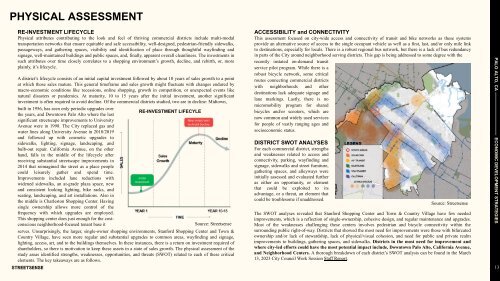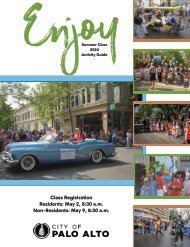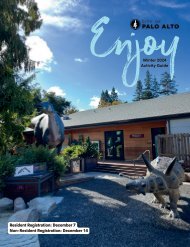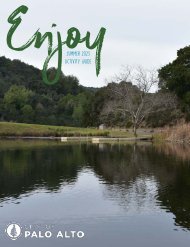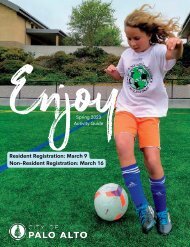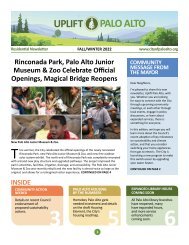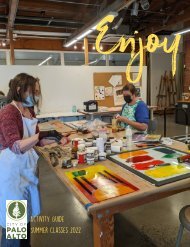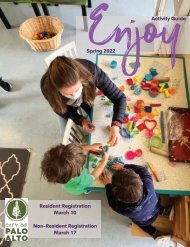Palo Alto Economic Development Strategies
Create successful ePaper yourself
Turn your PDF publications into a flip-book with our unique Google optimized e-Paper software.
PHYSICAL ASSESSMENT<br />
RE-INVESTMENT LIFECYCLE<br />
Physical attributes contributing to the look and feel of thriving commercial districts include multi-modal<br />
transportation networks that ensure equitable and safe accessibility, well-designed, pedestrian-friendly sidewalks,<br />
passageways, and gathering spaces, visibility and identification of place through thoughtful wayfinding and<br />
signage, well-maintained buildings and public spaces, and, finally, apparent overall cleanliness. The investments in<br />
such attributes over time closely correlates to a shopping environment’s growth, decline, and rebirth, or, more<br />
plainly, it’s lifecycle.<br />
A district’s lifecycle consists of an initial capital investment followed by about 10 years of sales growth to a point<br />
at which those sales mature. This general timeframe and sales growth might fluctuate with changes endured by<br />
macro-economic conditions like recessions, online shopping, growth in competition, or unexpected events like<br />
natural disasters or pandemics. At maturity, 10 to 15 years after the initial investment, another significant<br />
investment is often required to avoid decline. Of the commercial districts studied, two are in decline: Midtown,<br />
built in 1956, has seen only periodic upgrades over<br />
the years, and Downtown <strong>Palo</strong> <strong>Alto</strong> where the last<br />
significant streetscape improvements to University<br />
Avenue were in 1998. The City replaced gas and<br />
water lines along University Avenue in 2018/2019<br />
and followed up with cosmetic upgrades to<br />
sidewalks, lighting, signage, landscaping, and<br />
bulb-out repair. California Avenue, on the other<br />
hand, falls in the middle of the lifecycle after<br />
receiving substantial streetscape improvements in<br />
2014 that reimagined the street as a place people<br />
could leisurely gather and spend time.<br />
Improvements included lane reductions with<br />
widened sidewalks, an at-grade plaza space, new<br />
and consistent looking lighting, bike racks, and<br />
seating, landscaping, and art installations. Also in<br />
the middle is Charleston Shopping Center. Having<br />
single ownership allows more control of the<br />
frequency with which upgrades are employed.<br />
This shopping center does just enough for the costconscious<br />
neighborhood-focused tenant base it<br />
RE-INVESTMENT LIFECYLE<br />
Initial<br />
Investment<br />
Source: Streetsense<br />
serves. Unsurprisingly, the larger, single-owner shopping environments, Stanford Shopping Center and Town &<br />
Country Village, have seen more regular and substantial upgrades to common areas, wayfinding and signage,<br />
lighting, access, art, and to the buildings themselves. In these instances, there is a return on investment required of<br />
shareholders, so there is motivation to keep these assets in a state of sales growth. The physical assessment of the<br />
study areas identified strengths, weaknesses, opportunities, and threats (SWOT) related to each of these critical<br />
elements. The key takeaways are as follows.<br />
ACCESSIBILITY and CONNECTIVITY<br />
This assessment focused on city-wide access and connectivity of transit and bike networks as these systems<br />
provide an alternative source of access to the single occupant vehicle as well as a first, last, and/or only mile link<br />
to destinations, especially for locals. There is a robust regional bus network, but there is a lack of bus redundancy<br />
in parts of the City around neighborhood serving districts. This gap is being addressed to some degree with the<br />
recently instated on-demand transit<br />
service pilot program. While there is a<br />
robust bicycle network, some critical<br />
routes connecting commercial districts<br />
with neighborhoods and other<br />
destinations lack adequate signage and<br />
lane markings. Lastly, there is no<br />
micromobility program for shared<br />
bicycles and/or scooters, which are<br />
now common and widely used services<br />
for people of vastly ranging ages and<br />
socioeconomic status.<br />
DISTRICT SWOT ANALYSES<br />
For each commercial district, strengths<br />
and weaknesses related to access and<br />
connectivity, parking, wayfinding and<br />
signage, sidewalks and street furniture,<br />
gathering spaces, and alleyways were<br />
initially assessed and evaluated further<br />
as either an opportunity, or element<br />
that could be exploited to its<br />
advantage, or a threat, an element that<br />
could be troublesome if unaddressed.<br />
Source: Streetsense<br />
The SWOT analyses revealed that Stanford Shopping Center and Town & Country Village have few needed<br />
improvements, which is a reflection of single-ownership, cohesive design, and regular maintenance and upgrades.<br />
Most of the weaknesses challenging these centers involves pedestrian and bicycle connectivity within the<br />
surrounding public right-of-way. Districts that showed the most need for improvements were those with bifurcated<br />
ownership and/or lack of stewardship, lack of physical/visual cohesion, and need for public and private realm<br />
improvements to buildings, gathering spaces, and sidewalks. Districts in the most need for improvement and<br />
where city-led efforts could have the most potential impact include, Downtown <strong>Palo</strong> <strong>Alto</strong>, California Avenue,<br />
and Neighborhood Centers. A thorough breakdown of each district’s SWOT analysis can be found in the March<br />
13, 2023 City Council Work Session Staff Report.<br />
PALO ALTO, CA —————————— ECONOMIC DEVELOPMENT STRATEGIES<br />
13


